I test drove an EV for a week. Here's why I'm not running to the dealership just yet
Neither the soft electrical whir of the battery powering the motor, nor the feature that let me stop and go with just the acceleration pedal, really made me feel like I was behind the wheel of an electric vehicle.
I tested out an EV for a week to better understand what it could be like to own one and how much my driving habits would change. And overall, the 2023 Chevrolet Bolt EUV, which stands for “electric utility vehicle,” drove like any new gas-powered car on the market — without a roaring engine or tailpipe emissions.
That’s not meant to diminish the absolutely incredible technology behind these cars, but rather to say: Hey, don’t knock it ‘til you try it.
The Bolt EUV rolled smoothly on city roads and Interstate 95 as if gliding on ice. The acceleration picked up quickly — it boasts 200 horsepower and can get from 0 to 60 in seven seconds, after all — dispelling any preconceived notion that the power behind EVs is lacking.
But the difference between an EV and gas-powered car was more apparent when I needed to fuel, er, charge up.
Since I can’t charge an EV at home, I needed to seek out a fast-charging station in preparation for a long drive to western Palm Beach County. In my 15 years of driving, I know there’s a gas station on almost any street corner. But without apps or maps guiding me, would I know where to find a place to charge?
For subscribers: Sunshine State is primed for an electric vehicle revolution. Are the right pieces of the puzzle in place?
More:Bill could stop Palm Beach County's plan to boost electric vehicle chargers
More:Brace yourself for Florida Power & Light bills to increase at least thrice in 2023
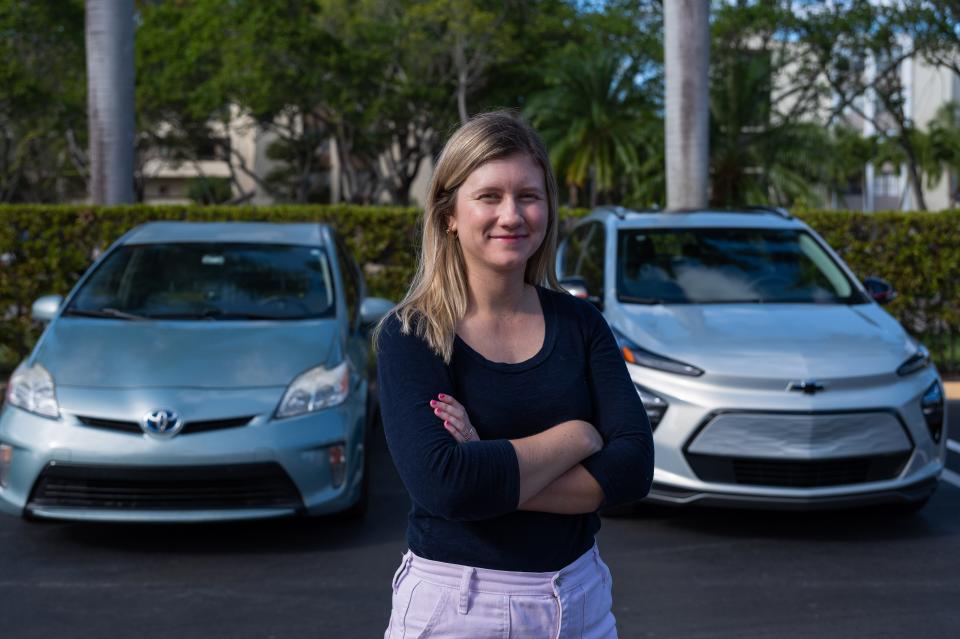
Now, I consider myself to be a relatively observant person. But I could have fooled anyone after discovering a fast-charging station in the parking lot of a Target that I frequent more than I care to admit. It was as if a blindfold was lifted from my eyes, revealing the collection of tall white Electrify America structures for the first time. How long have they been there? How did I miss the bright green glow they emit?
Let’s chalk it up to what I’m now calling “internal combustion engine oblivion.”
When talking to friends and family about EVs, the response I get is a lot of hesitation and even more questions. The most common concerns relate to how far the car can get on a single charge, referred to as “range anxiety,” and whether they can easily find a charging station so as to not become stranded.
Have you ever let your phone drain to empty? Now take that to a whole new level. Imagine telling your boss, “Sorry I’m late. I forgot to charge my car.”
I knew I wanted my next car to be an EV, even before this test drive. When I bought my first car seven years ago, I narrowed my search to only hybrids, mostly because of the fuel economy, and ended up with a used 2015 Toyota Prius. I can’t imagine ever going back — only forward into all-electric.
And if I were in the market for a car right now, I’d have been at a dealership yesterday considering my options. (And before you ask, General Motors, which loaned me the car, had no input in this story.)
If you’re looking for a new ride, I would recommend at the very least considering an EV, new or used. But any hesitation is understandable. More car manufacturers are starting to show off their EV options, albeit limited and sometimes pricey.
All said, it’s up to personal preference and it’ll take some time to reflect on how you drive. Can you charge at home, or will you need to plan a charge at work, when shopping or out to eat? How much do you drive in a day? In a week?
Here’s my experience.
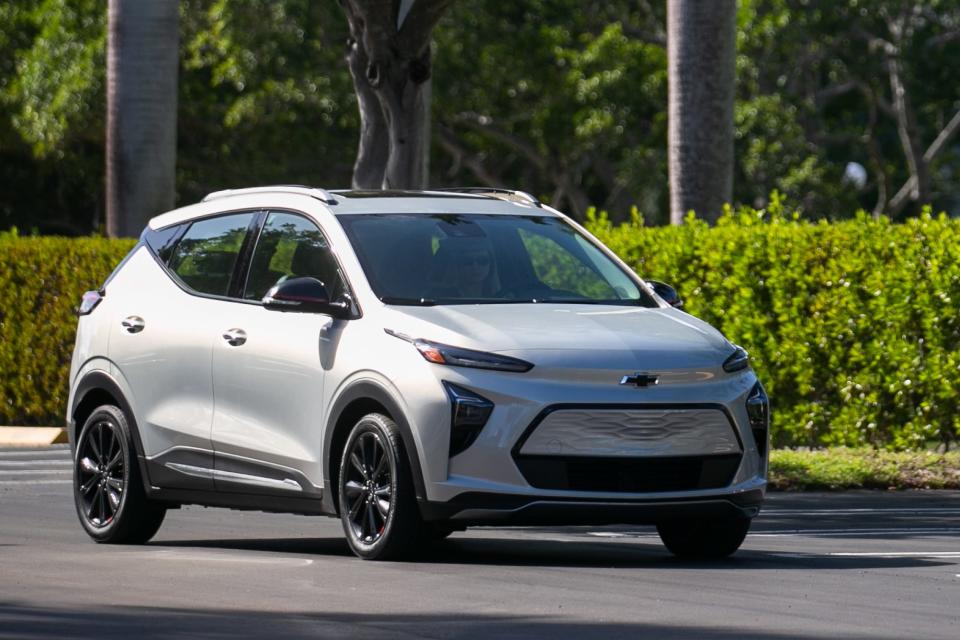
How’s the electric car drive?
My interaction with electric vehicles had previously been pretty minimal.
I was a passenger in a Tesla Roadster in 2016, which at the time could go from 0 to 60 in under four seconds. The driver stomped on the accelerator, and the car sped off so fast my brain felt like it shifted to the back of my skull. Over the holidays last year, I test-drove my brother-in-law’s 2013 Tesla Model S, and immediately afterward, I was scouring Autotrader for a good deal.
I’m no car expert. But if there’s one thing I do know, it's that EVs are fun to drive.
Some might think that driving an all-electric vehicle is akin to driving a Prius. I use the ECO mode setting in my car, which slightly diminishes the gas pedal response so as to get better fuel efficiency and not waste gas speeding off after a stop.
But fret not: It's nothing like the acceleration response I experienced driving the Tesla or Bolt EUV.
Extra features may depend on the make and model, but this EUV sports the one-pedal driving feature and an assisted-driving mode called “Super Cruise.” One-pedal driving is just like it sounds: You press on the acceleration to move and lift up to slow to a stop. It’s useful for stop-and-go traffic, and I tested it out briefly on Lantana Road.
It took a few tries to get it right, with the practice of angling my foot back and forth between the gas and brake pedal ingrained in me. There were times that the car didn’t slow down fast enough, so the brake pedal came in handy there. It did feel odd being completely stopped without pressing down on the brake pedal.
Traveling on I-95 is already white knuckle-inducing, but throwing the Bolt’s “Super Cruise” feature into the mix didn’t make the voyage any less unsettling. It wasn't the car I didn’t trust, but rather other drivers and how the car would react. What would it do if another driver drifted into my lane? What about a driver performing the “South Florida exit,” crossing up to five lanes of traffic to make the off-ramp?
I never found out. But even for the brief moment I used it, “Super Cruise” was super cool.
Engaging this feature allows the car to take over the steering wheel and drive to a set speed. The technology isn’t fully self-driving (software over which Tesla just issued a recall), but it will keep the car in your lane as well as slow down or speed up to the set speed, depending on the distance to the car in front of you. It is only available on certain roads, and you must be facing forward and be ready to take over if the car asks for it.
There was one point when several cars in front of me slammed on their brakes, and the green light suddenly flashed red. At that point I took over driving, which was seamless to do.
How far can you get on an electric car charge?
If your idea of an electric car is akin to the GM EV1, which debuted in the late 1990s with a Jetsons-like feel, a range of about 50 miles and 137 horsepower, think again.
Electric vehicles on the market today have full-charge ranges as low as 100 miles, like the 2023 Mazda MX-30, and as high as 520 miles, as seen in the Lucid Air Dream Edition. These cars cost anywhere between $25,000 and over $150,000. The Bolt EUV, which is slightly larger than its compact Bolt EV counterpart and starts at about $29,000, is roughly in the middle of the pack at 247 miles on its fully charged 65-kilowatt battery.
But just because it can get 247 miles, doesn’t mean it always will — or should all the time.
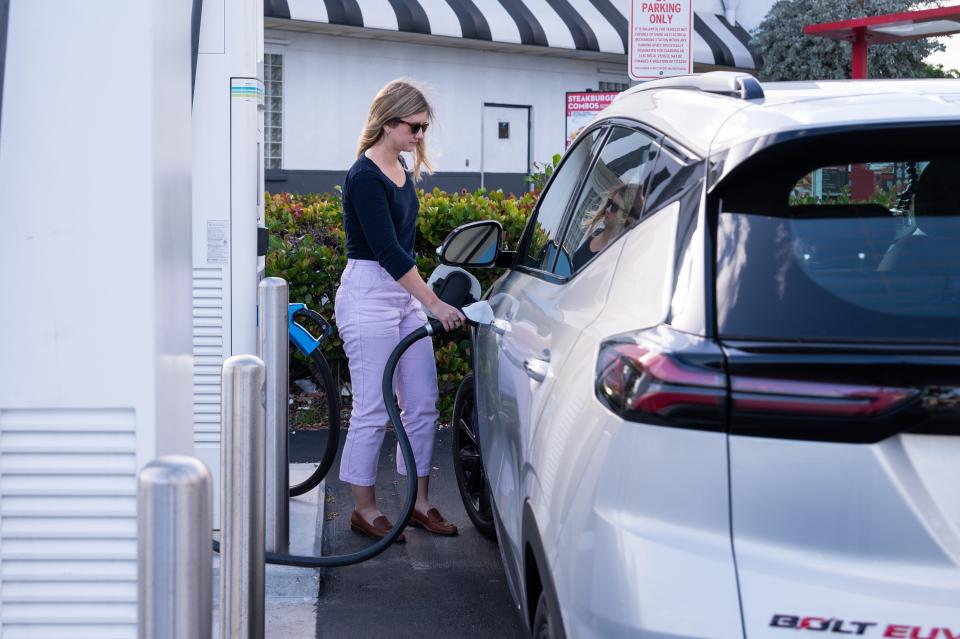
How you drive, what the road conditions are like or even the temperature can affect the overall range of the EV.
It is possible to charge an EV to 100% during each charging session, but experts recommend to top out at 80% unless absolutely needed, and don’t let it get below 20%. This will be better for the overall health of the lithium-ion batteries.
Frequently fast-charging these batteries, or charging them every session to 100%, can cause them to degrade faster. Plus, it takes just as long to charge an EV battery from empty to 80% as it does from 80% to 100%, if not longer.
It’s a similar concept to charging your phone overnight. Rather than immediately charge its lithium-ion batteries to 100% and stay there for several hours, the device is timed so charging will finish around the time you wake up.
The commercial fast-charging stations would only juice the car to 80%, meaning I’d get about 200 miles, not 247. By comparison, my Prius gets about 480 or so miles on a nine-gallon tank of gas. Even so, I only really felt the need to charge the car twice in that week. I made the 40-mile round trip to work every day, ran errands and took a day trip to play golf in Belle Glade.
More:Energy efficiency can help Floridians save on bills. Will new rule help?
More:‘Huge, huge decision’: Solar advocates laud veto to proposed net metering changes
Ahead of that drive, I punched the address into Apple Maps and calculated the distance from my apartment to Belle Glade.
Sixty miles one way? Okay, at least 120 miles, if not slightly more. Starting at about 200 miles, that would leave me with almost 80 miles of wiggle room when I returned home. I did the math again, and again to triple-check. Add, subtract, repeat.
On the drive I found my eyes drifting every so often from the rows of sugar cane to the car’s battery levels, just to make sure my math was actually right. But really, there was no need.
Longer drives in an EV will need more forethought and maybe time in the case of a road trip. But I could have eased my concern, probably brought on by using this tech for the first time, by using the apps at my disposal to locate the public charging station closest to my destination (at a gas station in Royal Palm Beach, by the way).
Gas stations are more obvious, with large signs advertising their prices and locations, while electric vehicle charging stations are more discreet. It’s probably for the fact that all the real estate it needs to function is a parking space and not necessarily a whole corner lot.
There are a lot more stations out there than you probably think. Certainly more than I thought.
A popular EV charging station map app called PlugShare shows countless pins across South Florida, most heavily concentrated around city centers or highways. And that number is set to grow.
How long did it take to recharge the EV battery?
Some people chew their nails. Others are late without fail. My bad habit is tending to drive my car until it’s nearly empty, when the last gas bar starts to blink and the car shouts warning beeps to say I’m 20 miles from being stranded.
It never worried me because there’s usually a gas station just around the corner that will take me less than five minutes to fill up and be back on my way.
This won’t — can’t — be the case with an EV. Depending on the type of charger used and how low the battery is, it can take several hours or a fraction of one to recharge an EV.
More:Here are 9 climate change solutions you, as a Florida resident, can do today
More:Electric vehicle fires, though rare, are tough to extinguish
More:These West Palm Beach brothers fight climate change with their mangrove farm
Case in point: even though I didn’t need to charge just yet, I tested out the charging station at a friend’s apartment complex to get a feel for how it would work. My Prius isn’t a plug-in hybrid; instead, charging its battery requires using a combination of the internal combustion engine and regenerative braking. This type of braking, also in EVs, uses energy that would otherwise be lost when the car slows down.
Plugging the charger to the car for the first time was simple enough. The port is shaped like a fuel nozzle, and it was like plugging something into the wall. Once connected, the car let me know it would take almost six hours to charge from 124 miles to full.
Leaving the car plugged in and unattended felt unnatural. But I could check in on the status of the charge on this particular charging station’s phone app. Two hours later, I ended up with 40 additional miles, or 12 kilowatts, of charge.
I still needed to charge as much as I could ahead of the day trip out west, so I swung by the fast-charging station at my Target. Not knowing how long it might take me, I brought leftover pizza and thought about what TV series I could watch to help pass the time.
Two drivers were already connected, two ports were out of service, and another driver was waiting for a specific charger to free up.
That reminded me of waiting in long Costco lines for gas: While daunting, they cycle through relatively fast. If there were a line at a charging station — that is, if you can’t charge at home — the wait could be unbearable.
But once I parked and plugged in, my car said it would take around 20 minutes to charge 33 miles, from 60% to 80%. Much better than the first go-around.
The driver who was waiting for a spot to open up had finally pulled into the spot next to mine. She owned a Hyundai Ioniq 5 and loved it, having just taken a road trip to Canada and back. She could charge for free along the way through a partnership the carmaker has with Electrify America.
We chatted more about EVs over the loud industrial hum of the charging stations. The pizza I brought sat uneaten in the passenger seat.
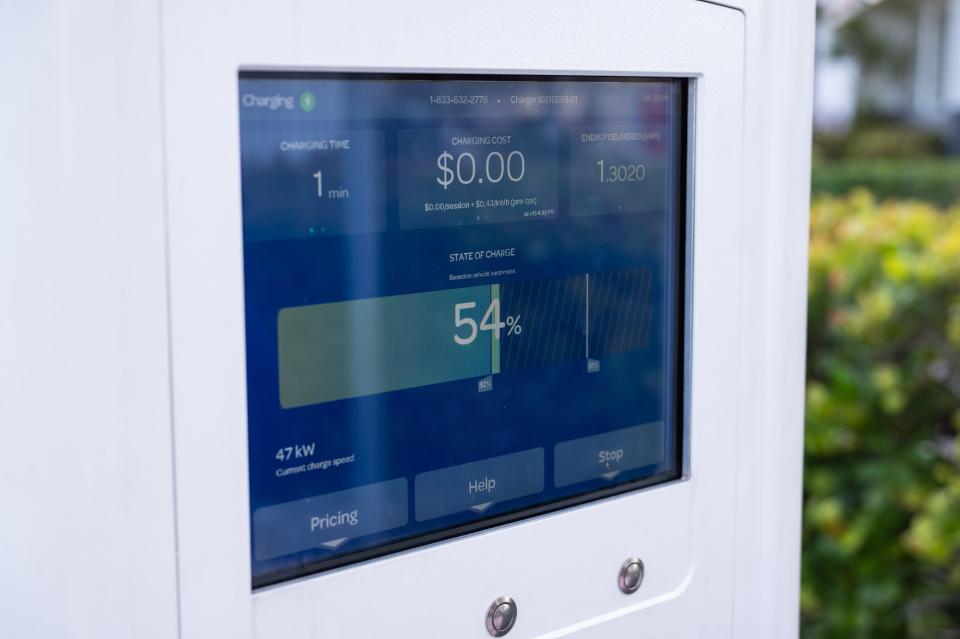
Thinking about the interaction later, I couldn’t help but chuckle, realizing that almost out of habit we had been standing outside of our cars for the whole time we charged up, as if we were filling our gas tanks at the pump.
Charging costs can vary, depending on the speed of the charger, how depleted the battery is, or whether you’re charging at home.
If you find yourself with an EV, you’ll likely be downloading a few apps to charge your car since there are dozens of charging station brands. Some stations have built-in credit card readers, but others’ payment systems are all phone-based. This might work out in the driver’s favor, not only for ease of paying, but also because some charging brands offer discounted rates through free or paid memberships.
Running a few errands one day, I decided to check out the charging stations at Town Center at Boca Raton. The car’s built-in map feature navigated me to the charging stations just outside Nordstrom.
It's here that I ran into some technical difficulties.
The mall had three different charging brands: Electrify America, SemaConnect (now Blink) and EVgo. I struck out at the first two stations, both of which couldn’t take my credit card. The third station required that I download a separate app, but after loading my credit card information, the app said the particular station was unavailable. Finally, a fourth charging station worked.
Each time, I had to repark. The Tesla driver sitting in his car was probably shaking his head the whole time.
At a charging speed of 33 kilowatts, it was going to take the car 55 minutes to get to 80% from 52 miles, or 19%. This station, another Electrify America one, gives drivers a 10-minute grace period after charging is finished before it charges an “idle time” fee to incentivize drivers not to overstay their welcome. I set a timer on my watch (information that I could have also tracked on the app) and was off to the mall.
EV stations charge either by the kilowatt hour of energy delivered or by the minute. The first two times I charged this car, I didn’t have to pay (I never figured out why, but hey, I’ll take it). There are some free charging stations, but they weren’t obvious to me. I found out by accident while researching for this story that the city of Boca Raton has seven free locations. It’s advertised on the city’s website, but I wouldn’t know from the PlugShare app unless I opened the specific location’s details.
This station at the Boca mall charged 43 cents per kilowatt hour, overall costing $16.24 including tax. That translates to 12 cents a mile for 135 miles of charge. But when recently filling up my Prius at $3.99 a gallon, I got 384 miles of range for $32.40, or 8 cents a mile.
Of course, charging the EV at a commercial station will cost more than charging at home. One of my followers on Twitter said that charging his Tesla at home added about $48 to his electric bill during one month. Other charging brands and utilities also offer their own home-charging systems. Florida Power & Light has a program to install a Level 2 slow charger at home for $38 a month, with unlimited charging on weeknights and on the weekend during off-peak hours.
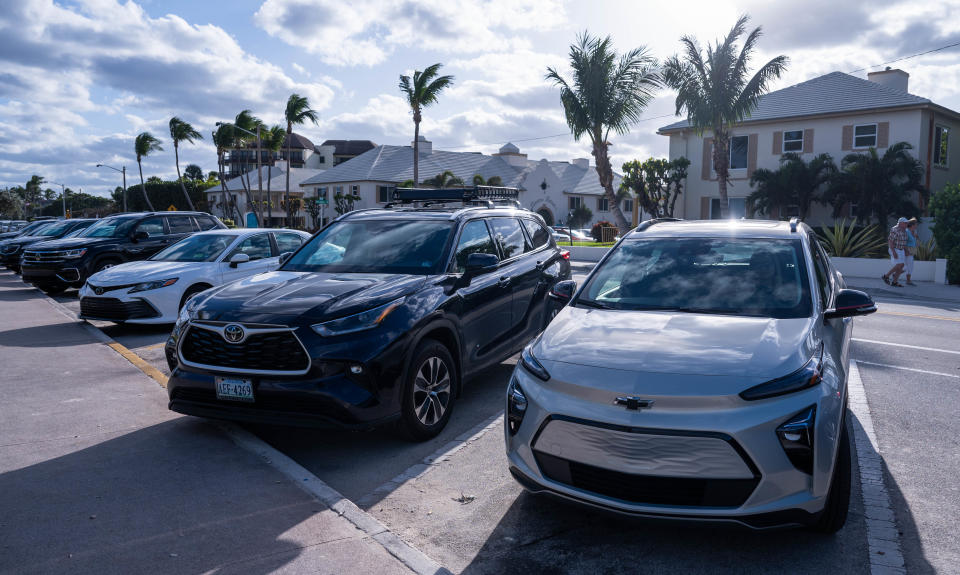
What's the verdict?
After my week with the Bolt EUV came to a close, I didn’t want to give it back. My Prius suddenly felt older, clunkier, louder than I had noticed before. There’s no doubt that I would have to adjust my driving habits if I had this particular EV, with how long it takes me to “fill up” and how often.
I’m not ready to give up my gas-powered hybrid car just yet, mostly because I finally own it outright and it still has some life to it at 120,000 miles.
What gives me pause right now is price, range and the lack of ability to charge at home.
The Chevy Volt EUV has decent range for a decent price, considering the high costs and limited options not even five years ago. Just a handful of new EVs are going for under $30,000, but other financial aspects to consider are the federal tax credit, little to no maintenance costs and potentially free fuel.
I could see myself having an EV with slightly less range than my Prius — maybe one with a 300-mile-or-greater range at 80% charge — but it would take getting used to driving with half of my current range.
And while I can build in charging time when I’m out of the house, coupled with the appeal of free charging, being able to charge at home would be more convenient.
All that said, I’m going to hold off on making the switch.
But I know that day isn’t too far out of reach.
Hannah Morse covers consumer issues for The Palm Beach Post. Drop a line at hmorse@pbpost.com, call 561-820-4833 or follow her on Twitter @mannahhorse.
This article originally appeared on Palm Beach Post: Test driving EV taught me about range anxiety, charging electric car

